These photos were taken by William Preston Bowling in 2009.
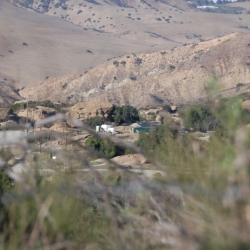 Another outfall.
Another outfall.
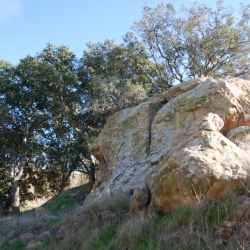 The environment's beauty belie its troubled history.
The environment's beauty belie its troubled history.
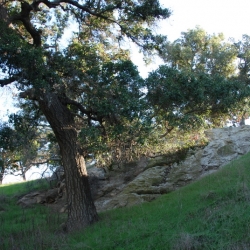 The trees provide abundant shade.
The trees provide abundant shade.
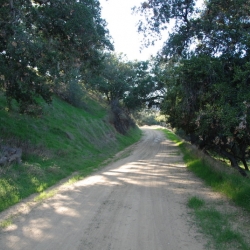 One of the most gorgeous stretches in the area.
One of the most gorgeous stretches in the area.
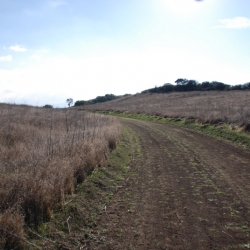 Road to Runkle
Road to Runkle
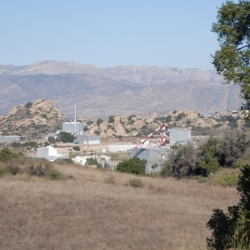 Rocketdyne 2009
Rocketdyne 2009
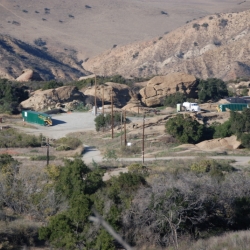 ... so polluted that huge areas of it are sandbagged and blocked in an attempt to dilute the toxins pouring off of "The Hill."
... so polluted that huge areas of it are sandbagged and blocked in an attempt to dilute the toxins pouring off of "The Hill."
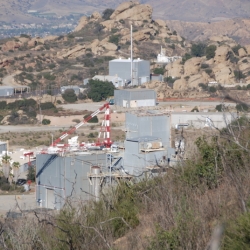 ... of an historic site...
... of an historic site...
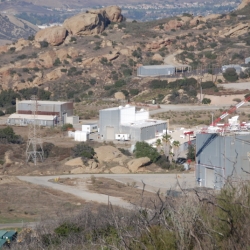 Different angles...
Different angles...
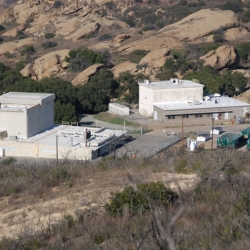 Large white buildings in Area IV.
Large white buildings in Area IV.
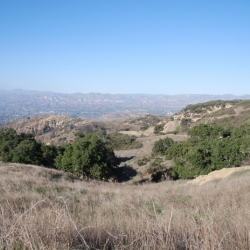 Heading west and looking at Simi Valley to the north.
Heading west and looking at Simi Valley to the north.
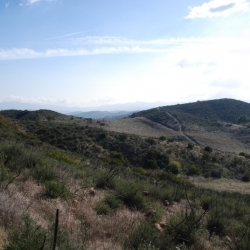 This road connects all the open space between Rocketdyne and points west including Ahmanson Ranch, Runkle Ranch, Cheseboro and beyond.
This road connects all the open space between Rocketdyne and points west including Ahmanson Ranch, Runkle Ranch, Cheseboro and beyond.
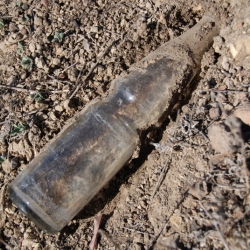 Some things last forever in this kind of environment, like this decades-old soda bottle. Unfortunately, gross radiological and chemical contamination have lasted as well.
Some things last forever in this kind of environment, like this decades-old soda bottle. Unfortunately, gross radiological and chemical contamination have lasted as well.
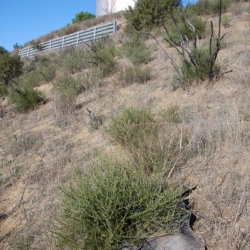 Looking up at the water tank.
Looking up at the water tank.
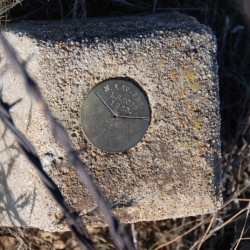 Not a mountain at this elevation but it was high enough.
Not a mountain at this elevation but it was high enough.
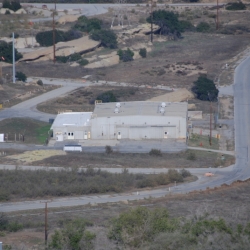 This is no dance hall.
This is no dance hall.
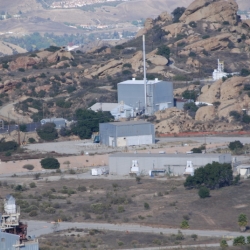 And yet the citizens have had to fight every step of the way to get government agencies to do their jobs and the landowners to clean up Rocketdyne.
And yet the citizens have had to fight every step of the way to get government agencies to do their jobs and the landowners to clean up Rocketdyne.
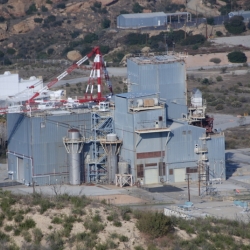 Taxpayer dollars to be sure.
Taxpayer dollars to be sure.
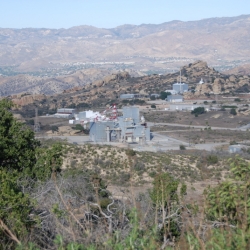 The cost of cleaning up this area has reached into the hundreds of millions of dollars.
The cost of cleaning up this area has reached into the hundreds of millions of dollars.
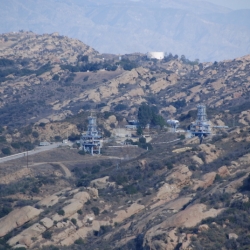 Two of the oldest test stands based on designs of Nazi slave driver who built the V-2 rocket which rained death upon London and Antwerp and went on to win a Congressional Medal of Honor for his pioneering work in the American rocket and space program, Wernher von Braun.
Two of the oldest test stands based on designs of Nazi slave driver who built the V-2 rocket which rained death upon London and Antwerp and went on to win a Congressional Medal of Honor for his pioneering work in the American rocket and space program, Wernher von Braun.
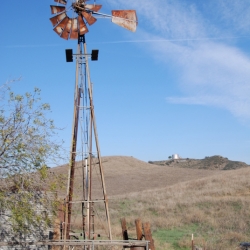 This is the windmill well OS-21 that KB Home blocked the U.S. Environmental Protection Agency from retesting again for radiation and chemicals after the well was positive for TCE, or trichloroethylene, in 2007. TCE has been detected in this well four times. Judging from TCE groundwater dispersion models, it seems odd that this well would have been contaminated from a plume. The tubes coming out of the jury-rigged larger tank into the well strongly suggest that TCE found in this well came from it being dumped and/or drained into it.
This is the windmill well OS-21 that KB Home blocked the U.S. Environmental Protection Agency from retesting again for radiation and chemicals after the well was positive for TCE, or trichloroethylene, in 2007. TCE has been detected in this well four times. Judging from TCE groundwater dispersion models, it seems odd that this well would have been contaminated from a plume. The tubes coming out of the jury-rigged larger tank into the well strongly suggest that TCE found in this well came from it being dumped and/or drained into it.
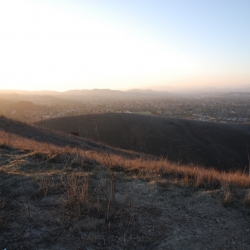 High in the hills of Simi Valley.
High in the hills of Simi Valley.
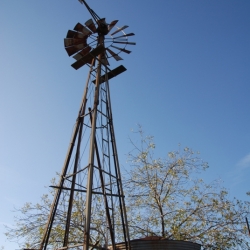 Does the existence of the OS-21 site with irrefutable evidence of toxic materials dumping call into question the honesty of the developer and the competency of the government?
Does the existence of the OS-21 site with irrefutable evidence of toxic materials dumping call into question the honesty of the developer and the competency of the government?
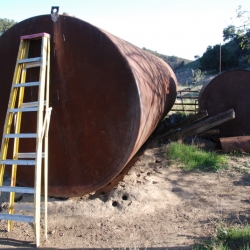 How did the Department of Toxic Substances Control grant a No Further Action on this property when this kind of toxic hazard, a huge tank of goo that has been drained into a well with TCE, exists and the department misses it?
How did the Department of Toxic Substances Control grant a No Further Action on this property when this kind of toxic hazard, a huge tank of goo that has been drained into a well with TCE, exists and the department misses it?
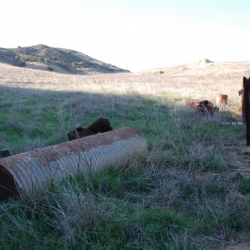 One of KB Home's representatives at the May 23, 2012 Simi Valley Planning Commission meetings responded in the negative about whether these tanks are still on site today.
One of KB Home's representatives at the May 23, 2012 Simi Valley Planning Commission meetings responded in the negative about whether these tanks are still on site today.
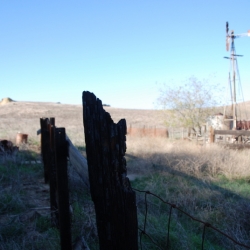 The extent of any contamination from these tanks and barrels is unknown. What is known is that the larger tank was drained through the tops coming out the top of it into the well. It follows that the well was used as a dump for chemicals and possibly radioactive liquid waste as evidence by the two smaller tanks, numerous barrels, animal skeletons throughout the site suggesting poisoning, and the identification tag on the largest tank that it was used underground for flammable liquids.
The extent of any contamination from these tanks and barrels is unknown. What is known is that the larger tank was drained through the tops coming out the top of it into the well. It follows that the well was used as a dump for chemicals and possibly radioactive liquid waste as evidence by the two smaller tanks, numerous barrels, animal skeletons throughout the site suggesting poisoning, and the identification tag on the largest tank that it was used underground for flammable liquids.
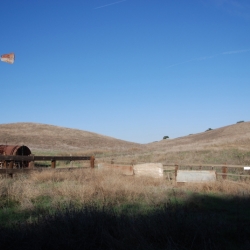 How did KB Home miss this yet know well enough to deny access to the government to test for TCE in its well? How did DTSC miss this before it signed a No Further Action Notice for Runkle Canyon? Who did this? Why did Boeing's lab MWH not note this in its 2007 report?
How did KB Home miss this yet know well enough to deny access to the government to test for TCE in its well? How did DTSC miss this before it signed a No Further Action Notice for Runkle Canyon? Who did this? Why did Boeing's lab MWH not note this in its 2007 report?
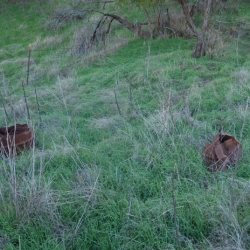 ... let unknown amounts and kinds of contamination course down under this barbed wire fence into Ahmanson Ranch and the upper Las Virgenes Creek, protected by the Clean Water Act.
... let unknown amounts and kinds of contamination course down under this barbed wire fence into Ahmanson Ranch and the upper Las Virgenes Creek, protected by the Clean Water Act.
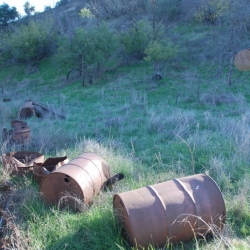 ... and down this slope these leaking barrels...
... and down this slope these leaking barrels...
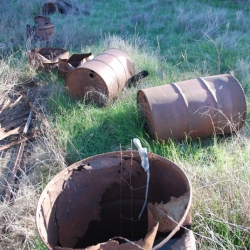 These barrels were probably drained into the ground...
These barrels were probably drained into the ground...
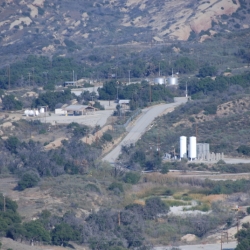 The road east through the Santa Susana Field Laboratory.
The road east through the Santa Susana Field Laboratory.
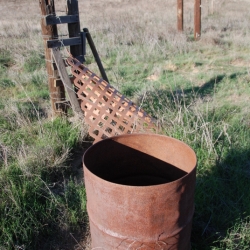 Mystery barrel.
Mystery barrel.
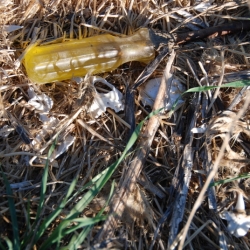 The ground is crunchy to walk on from the untold numbers of critters who drank what was being pulled up by this well and dropped death on the spot and decomposed to skeletons. Years of this has created a large animal graveyard of unburied bones in the grass.
The ground is crunchy to walk on from the untold numbers of critters who drank what was being pulled up by this well and dropped death on the spot and decomposed to skeletons. Years of this has created a large animal graveyard of unburied bones in the grass.
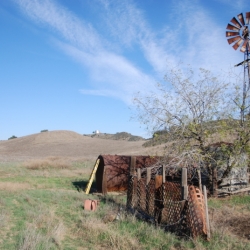 The place isn't exactly hidden.
The place isn't exactly hidden.
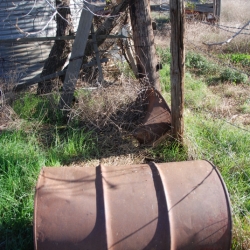 55-gallon drums were dumped here, contents unknown.
55-gallon drums were dumped here, contents unknown.
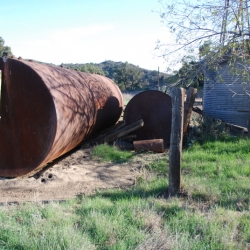 Huge tanks dumped at Runkle Canyon's windmill well, Offsite Well $#21 (OS-21)
Huge tanks dumped at Runkle Canyon's windmill well, Offsite Well $#21 (OS-21)
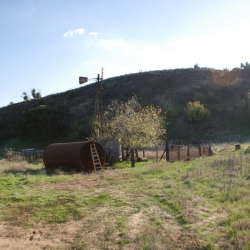 Two tanks that held underground flammable gas of some sort, perhaps radioactive or filled with monomethylhydrazine or trichloroethylene that was drained into the well years ago.
Two tanks that held underground flammable gas of some sort, perhaps radioactive or filled with monomethylhydrazine or trichloroethylene that was drained into the well years ago.
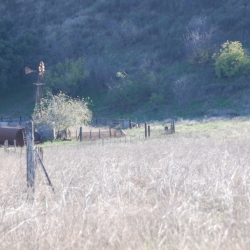 Runkle Canyon windmill well.
Runkle Canyon windmill well.
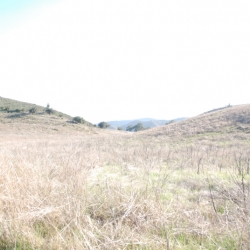 Dry Lake, the western part of Burro Flats.
Dry Lake, the western part of Burro Flats.
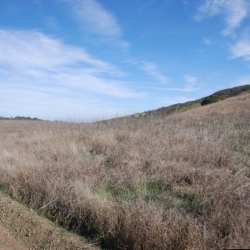 The AEIR addresses this lovely vista: "Included within the open space area is Dry Lake (in the western portion of Burro Flats), a large mesa on the crest of the Simi Hills in the southern portion of the site that has been designated for preservation in the City's General Plan."
The AEIR addresses this lovely vista: "Included within the open space area is Dry Lake (in the western portion of Burro Flats), a large mesa on the crest of the Simi Hills in the southern portion of the site that has been designated for preservation in the City's General Plan."
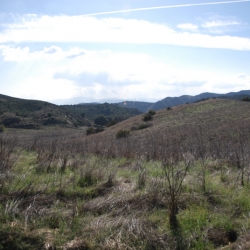 A vast mesa stretches west across the expanses.
A vast mesa stretches west across the expanses.
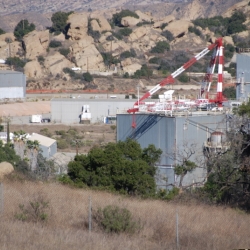 Area IV looks frozen in time, a time during the Cold War when three shifts work 24-7 at the plant on rockets that would form the backbone of America's nuclear arsenal.
Area IV looks frozen in time, a time during the Cold War when three shifts work 24-7 at the plant on rockets that would form the backbone of America's nuclear arsenal.
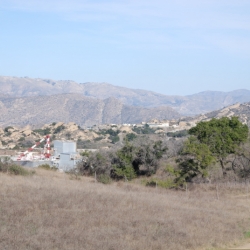 Workers burning radioactive goo in the Sodium Burn Pit would wait until the wind was blowing towards Runkle Canyon when they disposed of the toxic waste in a manner that would be illegal today. If they had let the predominant west wind carry away the airborne contamination, it would have nuked the lab worse than it already was getting exposed to a multitude of radionuclides.
Workers burning radioactive goo in the Sodium Burn Pit would wait until the wind was blowing towards Runkle Canyon when they disposed of the toxic waste in a manner that would be illegal today. If they had let the predominant west wind carry away the airborne contamination, it would have nuked the lab worse than it already was getting exposed to a multitude of radionuclides.
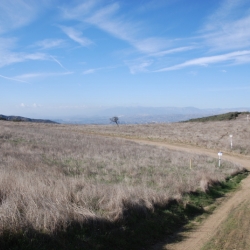 At the crossroads in Runkle Canyon, the roads lead to Rocketdyne.
At the crossroads in Runkle Canyon, the roads lead to Rocketdyne.
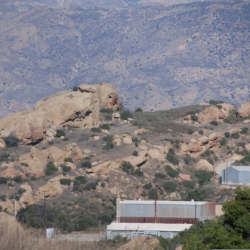 Area IV has an 11-acre drainage into Runkle Canyon but here rain-mobilized effluent goes down the Northern Drainage into the Brandeis-Bardin Campus of the American Jewish University.
Area IV has an 11-acre drainage into Runkle Canyon but here rain-mobilized effluent goes down the Northern Drainage into the Brandeis-Bardin Campus of the American Jewish University.
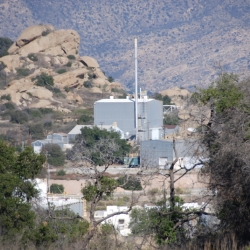 The building with the high stack is the Radioactive Materials Handling Facility. A 2007 Boeing report for the Department of Energy, which operates Area IV on land leased by Boeing, was $13 million.
The building with the high stack is the Radioactive Materials Handling Facility. A 2007 Boeing report for the Department of Energy, which operates Area IV on land leased by Boeing, was $13 million.
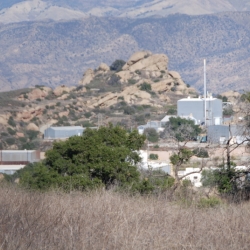 Area IV is where the worst meltdown in American history took place in 1959 at the Sodium Reactor Experiment releasing hundreds of times more radiation than Three Mile Island's meltdown did in 1979.
Area IV is where the worst meltdown in American history took place in 1959 at the Sodium Reactor Experiment releasing hundreds of times more radiation than Three Mile Island's meltdown did in 1979.
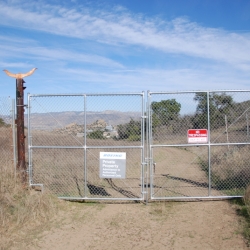 That's where Area IV of the Santa Susana Field Laboratory is. It's visible from hear right on the other side of that chain link fence.
That's where Area IV of the Santa Susana Field Laboratory is. It's visible from hear right on the other side of that chain link fence.
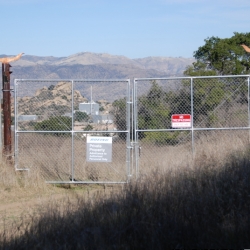 The eastern portion of Burro Flats is beyond that fence.
The eastern portion of Burro Flats is beyond that fence.
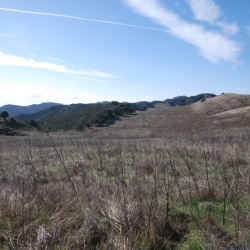 Mountain lions, coyotes, mule deer, rabbits and a variety of animals make this place their home.
Mountain lions, coyotes, mule deer, rabbits and a variety of animals make this place their home.
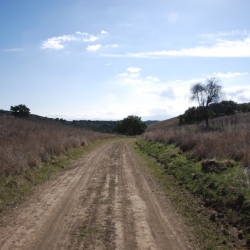 The public was not allowed to comment on this AEIR even though at least two residents had new information on the property's environment like the windmill well dump.
The public was not allowed to comment on this AEIR even though at least two residents had new information on the property's environment like the windmill well dump.
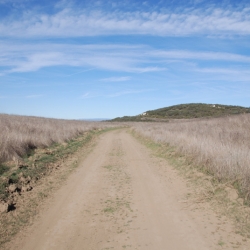 The city-generated Addendum to the Runkle Canyon Environmental Impact Report was not make public even though a PDF of it is 62 pages long and has new information.
The city-generated Addendum to the Runkle Canyon Environmental Impact Report was not make public even though a PDF of it is 62 pages long and has new information.
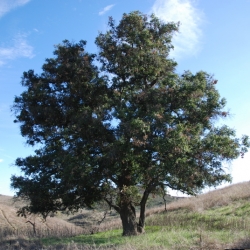 In 2006, even after learning of pollution concerns on the 1,595-acre property, the city of Simi Valley incorporated Runkle Canyon into its municipal borders.
In 2006, even after learning of pollution concerns on the 1,595-acre property, the city of Simi Valley incorporated Runkle Canyon into its municipal borders.
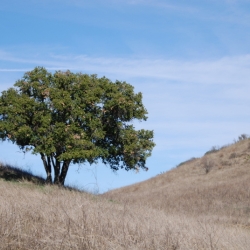 This ageless scene takes place in Simi Valley, not just the area but the city itself.
This ageless scene takes place in Simi Valley, not just the area but the city itself.
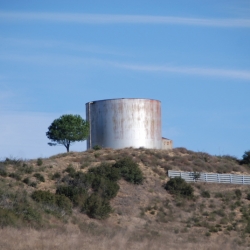 Water tank on hill overlooking Area IV on the other side of the rise.
Water tank on hill overlooking Area IV on the other side of the rise.
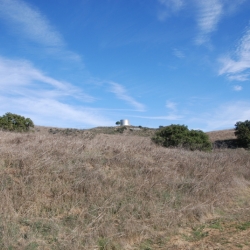 One of the attractions of the location when found in the 1940s was that it was hard to find.
One of the attractions of the location when found in the 1940s was that it was hard to find.
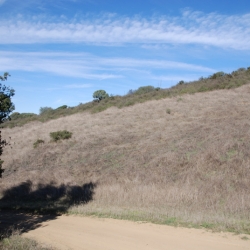 Looking east towards Area IV of the old Rocketdyne which isn't visible yet.
Looking east towards Area IV of the old Rocketdyne which isn't visible yet.
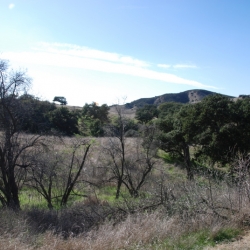 Ahmanson Ranch, Runkle Ranch and the Santa Susana Field Laboratory meet in this wooded hills.
Ahmanson Ranch, Runkle Ranch and the Santa Susana Field Laboratory meet in this wooded hills.
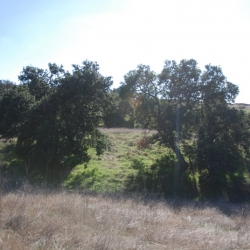 Runkle Canyon highlands where Runkle Canyon Creek water originates making its way down the Burro Flats Fault-carved canyon to the Arroyo Simi where it percolates into the ground, pumped back out, blended with imported water, then consumed by Simi Valley residents.
Runkle Canyon highlands where Runkle Canyon Creek water originates making its way down the Burro Flats Fault-carved canyon to the Arroyo Simi where it percolates into the ground, pumped back out, blended with imported water, then consumed by Simi Valley residents.
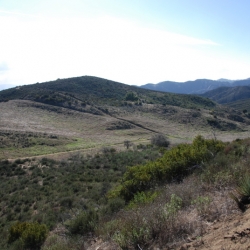 ... turning further right from this POV to the west....
... turning further right from this POV to the west....
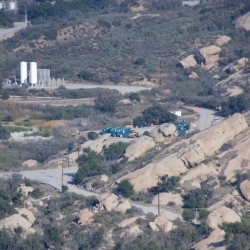 The green structures are part of an outfall created to try and trap and dissipate contamination before it sluices off the property during rain events.
The green structures are part of an outfall created to try and trap and dissipate contamination before it sluices off the property during rain events.
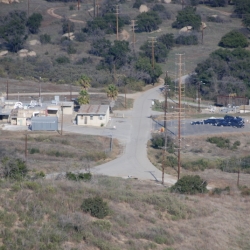 There used to be many more structures. Now it looks like an "Outer Limits" set.
There used to be many more structures. Now it looks like an "Outer Limits" set.
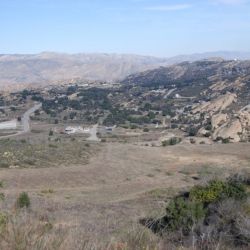 This vantage point offers unique views of Area IV.
This vantage point offers unique views of Area IV.
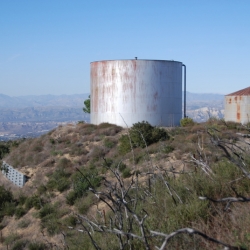 The water tank.
The water tank.
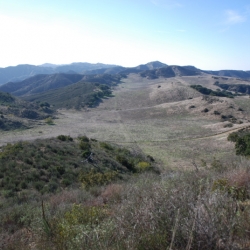 This is where Ahmanson Ranch, Runkle Ranch/Canyon and Rocketdyne come together
This is where Ahmanson Ranch, Runkle Ranch/Canyon and Rocketdyne come together
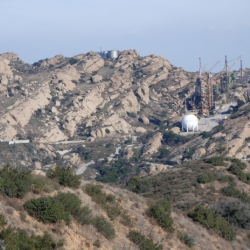 Superb views of far off rocket test stands to the east on SSFL.
Superb views of far off rocket test stands to the east on SSFL.
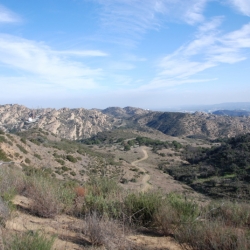 This is the way to get there. Should the underground flammable liquids tanks have come from industrious and devious workers wanting to ditch the contaminated contents off of SSFL, this is the road that would have had to been taken to move those multi-ton tanks to the windmill well.
This is the way to get there. Should the underground flammable liquids tanks have come from industrious and devious workers wanting to ditch the contaminated contents off of SSFL, this is the road that would have had to been taken to move those multi-ton tanks to the windmill well.
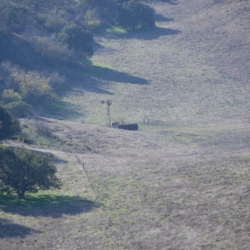 The Runkle Canyon windmill well.
The Runkle Canyon windmill well.
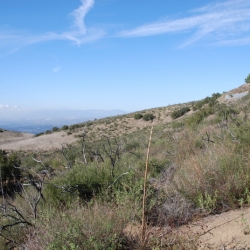 .... from up on the water tank hill you can see...
.... from up on the water tank hill you can see...
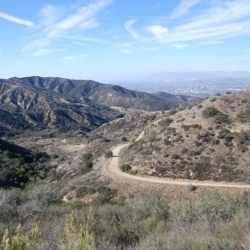 Runkle Canyon where previous developer Peter Kiesecker and now would-be home builder of Runkle Canyon, KB Home, have refused to test the creek water which it must do according to the Los Angeles Regional Water Quality Control Board. The creek is a 'blue line' stream meaning it should enjoy all the protections of the Clean Water Act.
Runkle Canyon where previous developer Peter Kiesecker and now would-be home builder of Runkle Canyon, KB Home, have refused to test the creek water which it must do according to the Los Angeles Regional Water Quality Control Board. The creek is a 'blue line' stream meaning it should enjoy all the protections of the Clean Water Act.
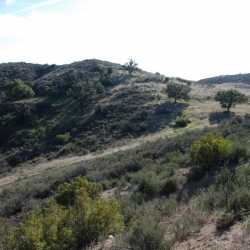 Panning right, or to the southwest...
Panning right, or to the southwest...
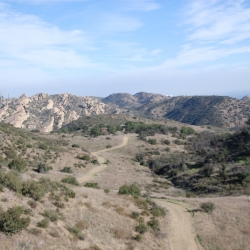 The way to Bell Canyon in the western San Fernando Valley.
The way to Bell Canyon in the western San Fernando Valley.
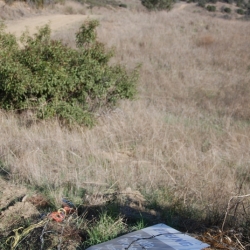 A Boeing sign in disrepair.
A Boeing sign in disrepair.
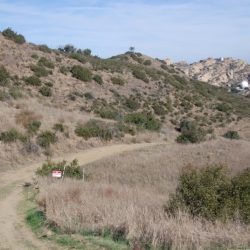 This road favored by mountain bikers cuts through Boeing's southern "buffer zone" between the lab and million dollar homes in Bel Canyon to the south.
This road favored by mountain bikers cuts through Boeing's southern "buffer zone" between the lab and million dollar homes in Bel Canyon to the south.
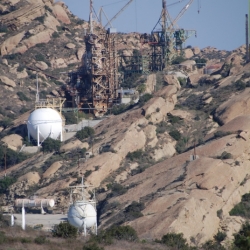 Rocket test stands that are inactive.
Rocket test stands that are inactive.
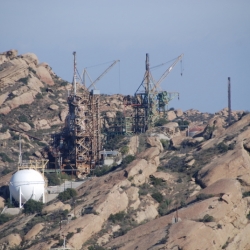 They seem surreal yet the contamination left behind is all too real.
They seem surreal yet the contamination left behind is all too real.
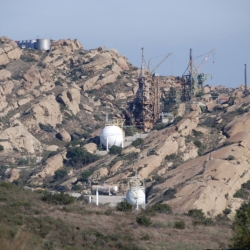 At a distance, a new angle afford a telescopic shot of a two enormous rocket test stand complexes further east in the 2,850-acre Rocketdyne complex.
At a distance, a new angle afford a telescopic shot of a two enormous rocket test stand complexes further east in the 2,850-acre Rocketdyne complex.
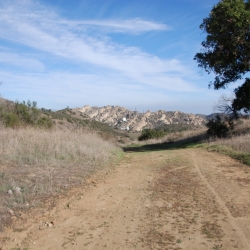 Hikers, mountain bicyclists and the occassional (and illegal) off-road motorcyclist use these high hills roads regularily.
Hikers, mountain bicyclists and the occassional (and illegal) off-road motorcyclist use these high hills roads regularily.
24 Years of Award-Winning SSFL/Rocketdyne Reporting
June 1998 – June 2022
 This is the windmill well OS-21 that KB Home blocked the U.S. Environmental Protection Agency from retesting again for radiation and chemicals after the well was positive for TCE, or trichloroethylene, in 2007. TCE has been detected in this well four times. Judging from TCE groundwater dispersion models, it seems odd that this well would have been contaminated from a plume. The tubes coming out of the jury-rigged larger tank into the well strongly suggest that TCE found in this well came from it being dumped and/or drained into it.
This is the windmill well OS-21 that KB Home blocked the U.S. Environmental Protection Agency from retesting again for radiation and chemicals after the well was positive for TCE, or trichloroethylene, in 2007. TCE has been detected in this well four times. Judging from TCE groundwater dispersion models, it seems odd that this well would have been contaminated from a plume. The tubes coming out of the jury-rigged larger tank into the well strongly suggest that TCE found in this well came from it being dumped and/or drained into it.
 The extent of any contamination from these tanks and barrels is unknown. What is known is that the larger tank was drained through the tops coming out the top of it into the well. It follows that the well was used as a dump for chemicals and possibly radioactive liquid waste as evidence by the two smaller tanks, numerous barrels, animal skeletons throughout the site suggesting poisoning, and the identification tag on the largest tank that it was used underground for flammable liquids.
The extent of any contamination from these tanks and barrels is unknown. What is known is that the larger tank was drained through the tops coming out the top of it into the well. It follows that the well was used as a dump for chemicals and possibly radioactive liquid waste as evidence by the two smaller tanks, numerous barrels, animal skeletons throughout the site suggesting poisoning, and the identification tag on the largest tank that it was used underground for flammable liquids.
 Workers burning radioactive goo in the Sodium Burn Pit would wait until the wind was blowing towards Runkle Canyon when they disposed of the toxic waste in a manner that would be illegal today. If they had let the predominant west wind carry away the airborne contamination, it would have nuked the lab worse than it already was getting exposed to a multitude of radionuclides.
Workers burning radioactive goo in the Sodium Burn Pit would wait until the wind was blowing towards Runkle Canyon when they disposed of the toxic waste in a manner that would be illegal today. If they had let the predominant west wind carry away the airborne contamination, it would have nuked the lab worse than it already was getting exposed to a multitude of radionuclides.
 Runkle Canyon where previous developer Peter Kiesecker and now would-be home builder of Runkle Canyon, KB Home, have refused to test the creek water which it must do according to the Los Angeles Regional Water Quality Control Board. The creek is a 'blue line' stream meaning it should enjoy all the protections of the Clean Water Act.
Runkle Canyon where previous developer Peter Kiesecker and now would-be home builder of Runkle Canyon, KB Home, have refused to test the creek water which it must do according to the Los Angeles Regional Water Quality Control Board. The creek is a 'blue line' stream meaning it should enjoy all the protections of the Clean Water Act.






















































































Recent Comments